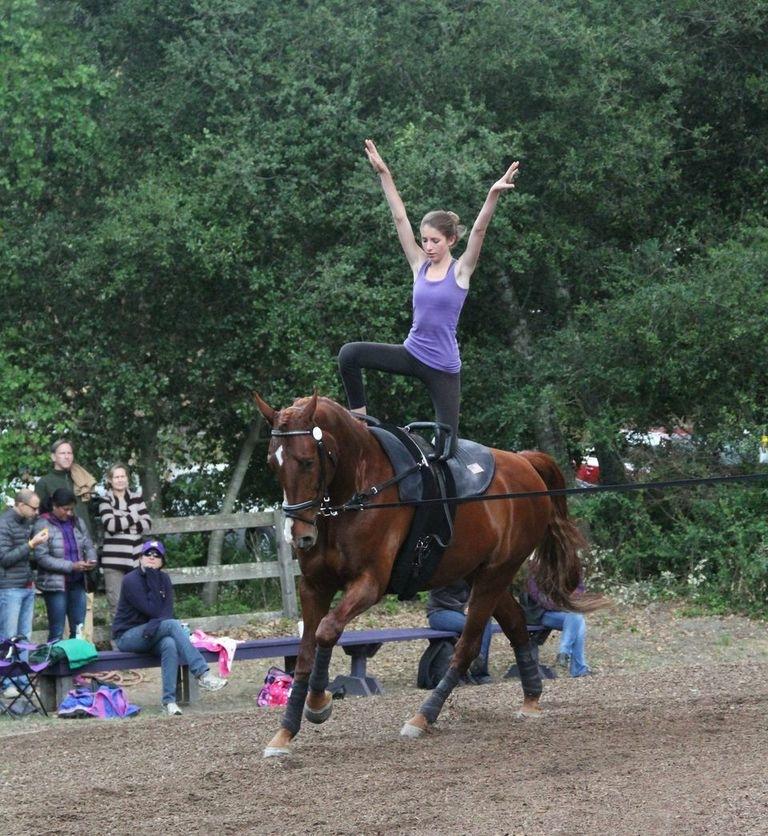When most people think of horseback riding, they think of sitting on a saddle. For Irene Ezran (‘14), however, riding a horse consists of standing and doing tricks to the beat of music on a horse’s back while it moves in a circle. Equestrian vaulting, or simply vaulting, is a combination of dance and gymnastics on a moving horse.
While the vaulters dance on the horse, the horse either walks, trots or canters in a circle, depending on how advanced the vaulter is. The horse is controlled by the lunger, who stands in the center of the circle and communicates with the horse during the competition.
Ezran first started vaulting two years ago after trying it out at a summer camp.
“I’ve been doing horseback riding for a really long time and I went to a horse summer camp when I was little and there was vaulting there,” Ezran said. “I really enjoyed it so I wanted to find a place where I could do it more regularly.”
Vaulting is not a well-known sport; Ezran doesn’t know many other vaulters, especially at the high school level, herself.
“There’s someone at Castilleja,” Ezran said. “I have another friend at Gunn who does it, but it’s just not a very common sport.”
Since vaulting is a unique sport, the girls look up to other vaulters from their club, such as Ezran, as one of the older girls who vaults at Woodside Vaulters.
“She definitely motivates the other girls she vaults with,” coach Megan Lanfri said. “She was one of the older girls of the group last year and she’s very mature.”
Lanfri enjoys coaching Ezran because of her respect for teammates and coach and her willingness to improve on all aspects of vaulting.
“She is very easy to coach, which is every coach’s dream,” Lanfri said. “She takes any kind of construction well and criticism she takes really well. If I tell her to correct something, she does it the next round. It’s pleasant to coach her as well. It’s nice to be able to work with somebody who’s so sweet and respectful to their coach.”
Irene also helps out her teammates before their competitions because of her ability to stay calm while others are tense.
“Everyone’s nervous when they compete, but Irene always seems so calm,” teammate Libby Horn wrote in an email to The Viking. “She doesn’t get worked up when we’re about to go out into the competition arena.”
Although Ezran competes and practices year round, she vaults more for recreational purposes. She generally practices once a week, and competes in multiple competitions at the end of the year.
Ezran does freestyle horse vaulting, which consists of 10 to 12 moves on the horse performed in one minute. The vaulters are then scored by a panel of judges based on their performance.
One of Ezran’s biggest accomplishments was being able to do freestyle for the whole year last year.
“Freestyle is where you express yourself,” Ezran said. “You get to choose what moves you do and you can pick music to go with it, so that takes a lot of work. I think that would be my biggest accomplishment from last year. It took me several months to put that together. You practice moves for the first half of the year just to see what you’re able to do, and then you finally put the moves together, pick the music and practice it a lot.”
Although vaulting may not be a common sport, some of Ezran’s favorite parts of vaulting are common in many other sports.
“There are so many aspects of vaulting that I enjoy, such as being part of a club, but I really love the adrenaline rush I get from performing my freestyle in front of a crowd at competitions,” Ezran wrote in an email to The Viking.
Vaulting is an extremely physical sport and requires lots of training and muscle strength.
“Training is not only on the horse, but also on the barrel and doing gymnastics, such as stretching, maintaining flexibility and building muscle strength,” Ezran wrote. “It is a physically strenuous sport, especially getting on the cantering horse by yourself.”
According to Ezran, however, vaulters are not injured as much as one might expect.
“The sport is not as dangerous as it seems because the horses are specially trained to remain very steady while vaulters practice on them,” Ezran wrote. “Vaulters do not wear helmets; they are taught to jump off the horse if they lose their balance, rather than fall.”
In the future, Ezran doesn’t believe that she will be able to continue vaulting because of how uncommon it is to find an equestrian vaulting club.
“I don’t think I will be able to continue in college,” Ezran said. “Maybe if I happen go to a college where there’s vaulting close to that area then I will continue, but it’s not very likely because it’s just so hard to find.”
Vaulting has similar qualities to other types of dancing, such as the need to be in rhythm, so vaulters often do dance in order to improve their vaulting skills.
“Many vaulters do gymnastics or dance in addition to vaulting,” Ezran wrote. “I did ballet when I was younger, which helped me because I am now more graceful on horses.”
Both dancing and vaulting also require strength and the ability to make the moves look smooth.
“Before every practice I do exercises that help me maintain my balance when I am on the horse at the canter,” Ezran wrote. “While I am comfortable practicing moves on the barrel, it is another story to perform them gracefully when the horse is moving so fast. To be in rhythm with the horse, I constantly have to be flexible and absorb the movements of the horse.”
The connection Ezran has with the horse while she vaults is one she loves and a major reason she enjoys vaulting so much.
“I really like the feeling of being in rhythm with the horse because it takes a lot of skill,” Ezran said. “It’s one thing to practice the moves on the ground or on a barrel, but once you’re on the horse everything happens so quickly. It’s really nice to have that feeling of being in rhythm with the horse.”
While rhythm may only be a small part of vaulting, it allows the vaulters be united with the horse in a way that other people can’t. Even though Ezran may not be able to vault much longer, her love for the sport will stay with her for a long time.




